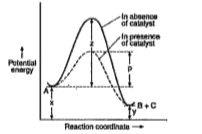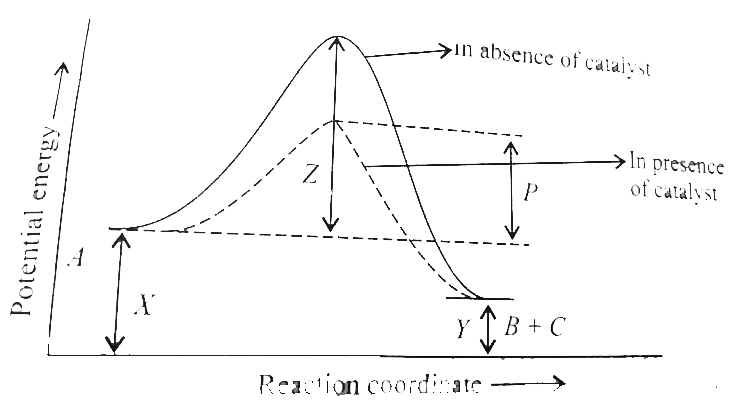For the reaction (A→B+C) , the energy profile diagram is given in the figure.

The decrease in energy of activation in presence of catalyst is: Solution in Malayalam
Z
z-p
y-z
z-x
The correct Answer is:B
Step by step video, text & image solution for For the reaction (A rarr B+C) , the energy profile diagram is given in the figure. The decrease in energy of activation in presence of catalyst is: by Chemistry experts to help you in doubts & scoring excellent marks in Class 12 exams.
Updated on:21/07/2023Similar Questions
A catalyst decreases activation energy by 15 Kcal and it is observed that rate of reaction in absence of catalyst at 400K is same as rate of reaction in presence of catalyst at 300 K. The activation energy in absence of catalyst will be :
View SolutionAt 227^@C , the presence of catalyst causes the activation energy of a reaction to decrease by 4.606 KCal, the rate of the reaction will be increased by:
View SolutionThe activation energy of a reaction is 100 kJ/mol. In the presence of catalyst the activation energy is decreased by 75%. What is the effect on rate constant of the reaction at 20^@ C ?
View SolutionDefine energy of activation. Draw a diagram of energy profile to show the influence of a positive catalyst on the energy of activation of a reaction.
View Solutionउत्प्रेरक की उपस्थिति में अभिक्रिया की सक्रियण ऊर्जा .........जाती है।
View SolutionSubstances which alter the velocity of a reaction by mere presence, without undergoing any change in mass and compossition are termed catalyst and the phenomenon is known as catalysis
For the reaction (A→B+C) , the energy profile diagram is given in the figure below.

The decrease in the energy of activation in the presence of catalyst is
View SolutionAt 227∘C , the presence of catalyst causes the activation energy of a reaction to decrease by 4.606Kcal.The rate of the reaction will be increased by :−
View SolutionAssertion: A catalyst increases the rate of a reaction.
Reason: In presence of a catalyst, the activation energy of the reaction decreases.
View Solution
